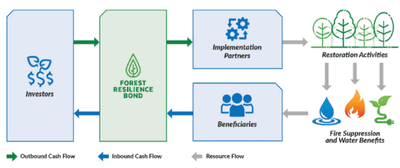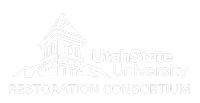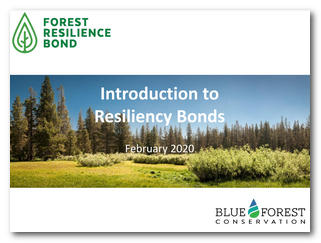Background
Despite tens of billions of dollars being spent annually on restoring riverscapes, we are nowhere near scratching the scope of the problem. There is way more work that needs to be done, than we are getting done. Restoration tends to be primarily be implemented with funding from grants and program-specific contracts. The vast majority of restoration funding comes from revenue from tax-payers and/or rate-payers (e.g. utilities and ) and a variety of mechanisms are used to make awards and get projects implemented. However, these standard methods of procurement are typically subject to local, state and/or federal contracting guidelines and limitations, and are difficult to organize for larger projects or plan for phased implementation. The current pace of spending and action is far too little.
 Similar problems exist in restoring forests. Some innovative thinkers from Blue Forest Conservation developed a Forest Resilience Bond as a mechanism to tackle some similar challenges faced in forest restoration.
Similar problems exist in restoring forests. Some innovative thinkers from Blue Forest Conservation developed a Forest Resilience Bond as a mechanism to tackle some similar challenges faced in forest restoration.
We are working with Blue Forest Conservation to expand the concept to other forms of restoration (riverscape, watershed and rangelands), and are working on getting projects going right here in the Bear River Watershed. You are going to be working on one LTPBR project at the heart of this effort. Blue Forest co-founder and COO Nick Wobbrock and Senior Project Associate Peter Wyrsch have generously offered to come meet with you and share these innovative conservation financing mechanisms that could be come critical tools in scaling up restoration efforts in your future.
Preparation for Discussion
Prior to class on Friday, please prepare by watching and reading the following:
1. Watch Era of Mega Fires
Please watch this TedX Talk to appreciate the scope of the wildfire and forest health problem.
TedX Talk - Living (Dangerously) in Era of Megafires
15 minutes by Paul Hessburg2. Watch - What is a resilience bond?
Next, watch this short video from Blue Forest to understand what a resilience bond is.
How Forest Resilency Bond Works
3 minutes3. Read “More than Finance”
Please read Wobbrock (2019) on “More than Finance: The Non-Monetary Benefits of the Forest Resilience Bond”.
4. Watch Lectures
In order to be prepared for our discussion with Nick and Peter, please watch their lectures below before class and come with questions.
Nick's Lecture
46 minutesPeter's Lecture
14 minutes5. Watch Ted Talk (Optional)
If this excites you, you may also want to watch Leigh Maderia’s talk.
TEDx Talk - Fighting Fire with Finance
12 minutes TedX TalkAdditional Resources and Further Information
Blue Forest Conservation is a nonprofit organization committed to creating sustainable financial solutions to pressing environmental challenges. In partnership with the US Forest Service and World Resources Institute, they recently launched the Forest Resilience Bond - the nation’s first financial product to support proactive management of National Forest System land. Engage with their Annual Impact Report here.
The Forest Resilience Bond deploys investor capital to finance the upfront costs of forest restoration in an effort to reduce the risk of catastrophic wildfire, avoid carbon emissions, and protect communities, water resources, and ecosystems. Check out this short How it works video to learn more.
- Partners: US Forest Service, World Resources Institute, Encourage Capital, National Forest Foundation, National Wild Turkey Federation, UC-Merced’s Sierra Nevada Research Institute, The Natural Capital Project and Water in the West at Stanford, and the Sierra Nevada Conservancy.
- Project Investors: The Rockefeller Foundation, The Gordon and Betty Moore Foundation, CSAA/AAA, Calvert Impact Capital
Homework
Additional Resources
Reports & Papers
- Convergence Blended Finance Report
- SF FED Publication
- CECS 2020 Paper Announcement of Forest Hydrology Interaction (or the actual paper)
News Coverage & Articles
- LA TimesArticle on “Start-up Blue Forest secures funding for first privately financed forest fire bond”: Nov 2018
- SSIR Article by the Moore Foundation
- Stanford’s Newsha Ajami on Water Quality Impact from Forest Fires
- Stanford Social Innovation Review Article on “Investing in Forest Health”
- CNBC Article and Video on “There’s a new way for investors to turn a profit while helping California prevent fires” : October 2019
- Discussion about the health impacts from wildfire smoke from Stanford here
Finance Basics
Podcast
Impact Alpha Podcast - On Agent of Impact with Blue Forest CEO Zach Knight:



